Related Research Articles

Robert Zubrin is an American aerospace engineer, author, and advocate for human exploration of Mars. He and his colleague at Martin Marietta, David Baker, were the driving force behind Mars Direct, a proposal in a 1990 research paper intended to produce significant reductions in the cost and complexity of such a mission. The key idea was to use the Martian atmosphere to produce oxygen, water, and rocket propellant for the surface stay and return journey. A modified version of the plan was subsequently adopted by NASA as their "design reference mission". He questions the delay and cost-to-benefit ratio of first establishing a base or outpost on an asteroid or another Apollo program-like return to the Moon, as neither would be able to provide all of its own oxygen, water, or energy; these resources are producible on Mars, and he expects people would be there thereafter.

Edgar Dean Mitchell was a United States Navy officer and aviator, test pilot, aeronautical engineer, ufologist and NASA astronaut. As the Lunar Module Pilot of Apollo 14, he spent nine hours working on the lunar surface in the Fra Mauro Highlands region, making him the sixth person to walk on the Moon.
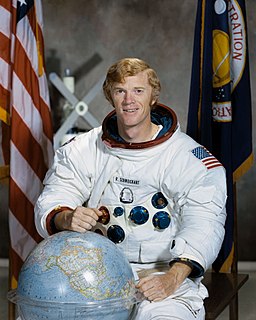
Russell Louis "Rusty" Schweickart is an American aeronautical engineer, and a former NASA astronaut, research scientist, U.S. Air Force fighter pilot, as well as a former business executive and government executive.
Charles Stark "Doc" Draper was an American scientist and engineer, known as the "father of inertial navigation". He was the founder and director of the Massachusetts Institute of Technology's Instrumentation Laboratory, later renamed the Charles Stark Draper Laboratory, which made the Apollo Moon landings possible through the Apollo Guidance Computer it designed for NASA.
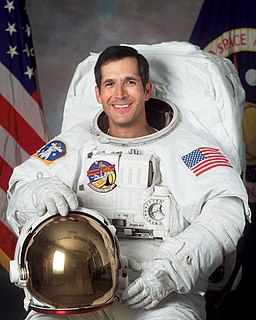
John Bennett Herrington is a retired United States Naval Aviator, engineer and former NASA astronaut. In 2002, Herrington became the first enrolled member of a Native American tribe to fly in space.
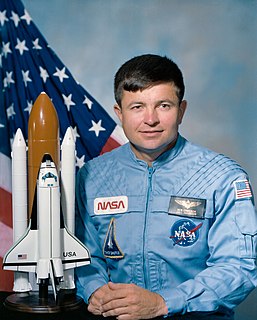
Kenneth Donald Cameron, , is a retired American naval aviator, test pilot, engineer, U.S. Marine Corps officer, and NASA astronaut.

Edward Michael "Mike"/"Spanky" Fincke is an American astronaut who formerly held the American record for the most time in space. His record was broken by Scott Kelly on October 16, 2015. In January 2019 Fincke was selected to fly on the first crewed flight of Boeing's CST-100 Starliner.
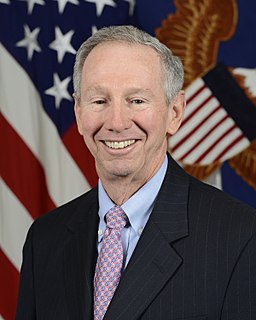
Michael Douglas Griffin is an American physicist and aerospace engineer who served as the Under Secretary of Defense for Research and Engineering from 2018 to 2020. He previously served as Deputy of Technology for the Strategic Defense Initiative, and as Administrator of NASA from April 13, 2005, to January 20, 2009. As NASA Administrator Griffin oversaw such areas as the future of human spaceflight, the fate of the Hubble telescope and NASA's role in understanding climate change. In April 2009 Griffin, who has an academic background, was named eminent scholar and a professor of mechanical and aerospace engineering at the University of Alabama in Huntsville.
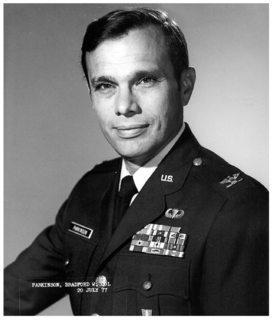
Bradford Parkinson is an American engineer and inventor, retired United States Air Force Colonel and Emeritus Professor at Stanford University. He is best known as the lead architect, advocate and developer, with early contributions from Ivan Getting and Roger Easton, of the Air Force NAVSTAR program, better known as Global Positioning System.
Pioneer Rocketplane was an aerospace design and development company intent on developing affordable manned space flight. The company is most famous for advocating a horizontal takeoff, turbo-jet and rocket propelled, aerial-refueled, rocket plane concept called the Pathfinder. The company still exists, but is no longer in operation. Pioneer's intellectual property is now owned by Rocketplane Limited, Inc., however Rocketplane Limited does not employ any of the principals of Pioneer Rocketplane.
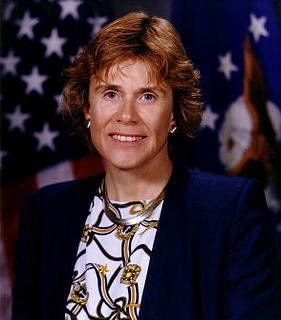
Sheila Marie Evans Widnall is an American aerospace researcher and Institute Professor Emerita at the Massachusetts Institute of Technology. She served as United States Secretary of the Air Force between 1993 and 1997, making her the first female Secretary of the Air Force and the first woman to lead an entire branch of the US military in the Department of Defense. She was inducted into the National Women's Hall of Fame in 2003.

Steve Altes is an American writer and former aerospace engineer. He writes humorous essays about his misadventures.
Eugene Edzards Covert was an aeronautics specialist born in Rapid City, South Dakota credited with the world's first practical wind tunnel magnetic suspension system, and was a member of the Rogers Commission. In the 1970s he was the chief scientist of the US Air Force and technical director of the European Office of Aerospace Research and Development.

Richard P. Hallion is Senior Adviser for Air and Space Issues, Directorate for Security, Counterintelligence and Special Programs Oversight, the Pentagon, Washington, D.C. He is responsible for analysis and insight regarding the conceptualization, evolution and utilization of sensitive national technological programs and related subject areas.

Joseph John "Tym" Tymczyszyn was an American World War II pilot, and test pilot for the United States Army Air Corps and the Federal Aviation Administration.
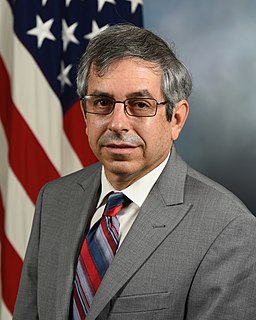
Dr. Mark J. Lewis is a senior American aerospace and defense executive with special expertise in hypersonics. He is currently the Executive Director of the National Defense Industrial Association's Emerging Technologies Institute, following his role in the second half of 2020 as the acting US Deputy Under Secretary of Defense for Research and Engineering, and before that the Director of Defense Research and Engineering for Modernization. He was the Chief Scientist of the U.S. Air Force, Washington, D.C. from 2004 to 2008 and was the longest-serving Chief Scientist in Air Force history. He served as chief scientific adviser to the Chief of Staff and Secretary of the Air Force, and provided assessments on a wide range of scientific and technical issues affecting the Air Force mission. In this role he identified and analyzed technical issues and brought them to attention of Air Force leaders, and interacted with other Air Staff principals, operational commanders, combatant commands, acquisition, and science & technology communities to address cross-organizational technical issues and solutions. His primary areas of focus included energy, sustainment, long-range strike technologies, advanced propulsion systems, and workforce development.
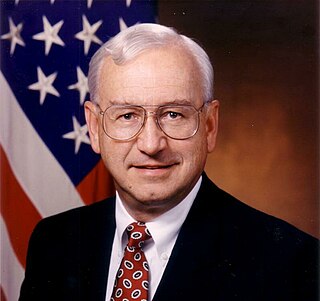
Paul Garrett Kaminski is a technologist and former U.S. government official, best known for his leading role in the development of stealth aircraft.
Holt Ashley was an American aeronautical engineer notable for his seminal research of aeroelasticity.

Mike Gruntman is a physicist, space engineer, and author. He is professor of astronautics and aerospace engineering at the Viterbi School of Engineering, University of Southern California (USC).

Warren J. North was an American test pilot and aeronautical engineer. He trained fighter pilots during World War II. After the war he studied aeronautical engineering and became a test pilot. He was Chief of the Flight Crew Support Division from 1962 to 1971, and Assistant Director for Space Shuttle, Flight Operations Directorate at the NASA Manned Spacecraft Center in Houston, Texas, from 1971 to 1985.
References
- 1 2 "Mitchell Burnside Clapp". 5 June 2015.
- 1 2 3 "Pegasus Awards - Mitchell Burnside-Clapp". Ohio Valley Filk Festival. Archived from the original on 2022-04-07. Retrieved 2022-06-12.
- ↑ Belfiore, Michael (November 2007). "The O Prize". Airspace Magazine. Archived from the original on 2022-06-12. Retrieved 2022-06-12.
- ↑ "Aviation's Next Great Leap". MIT Technology Review. January 1998. Archived from the original on 2022-06-12. Retrieved 2022-06-12.